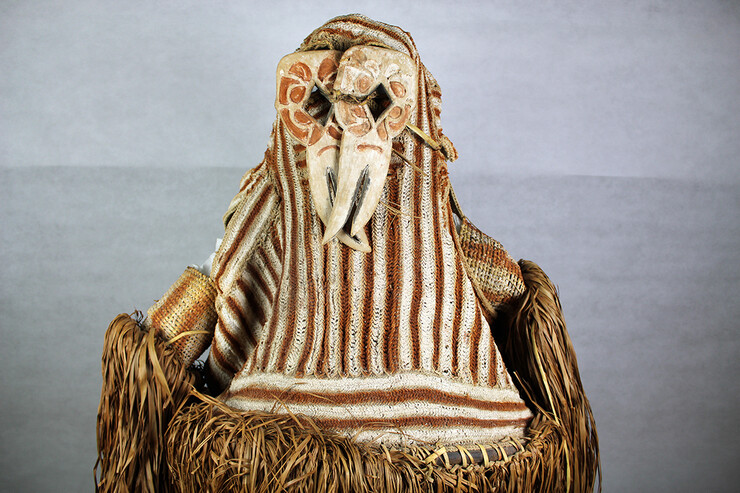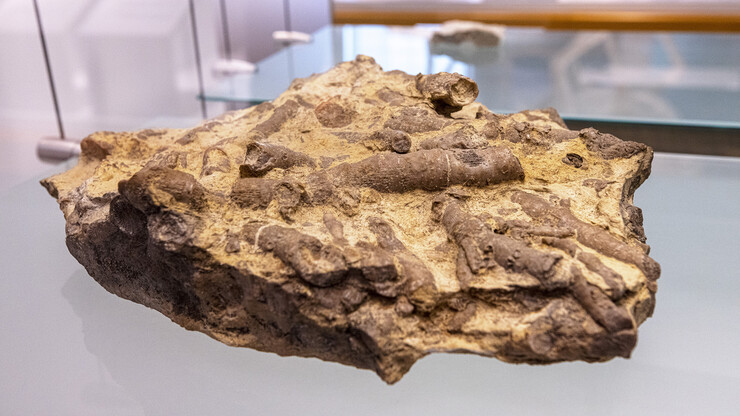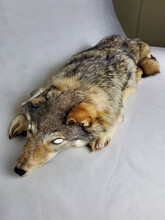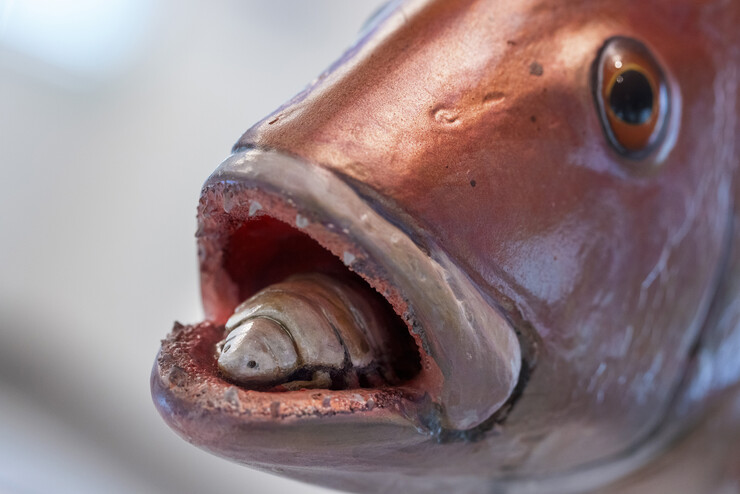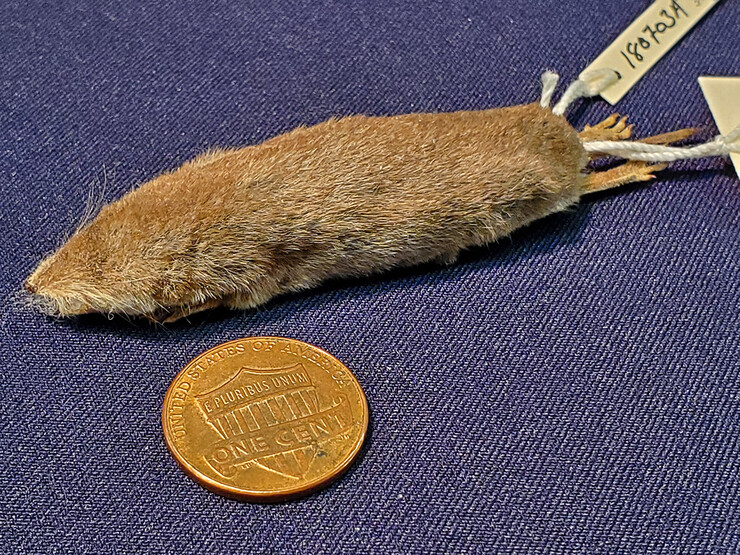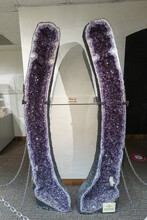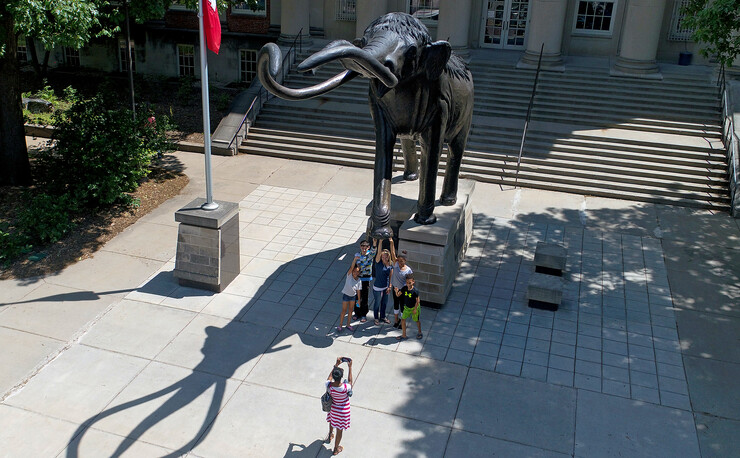· 7 min read
From mammoths to mini mammals, Morrill Hall has it all

Most visitors to the University of Nebraska State Museum–Morrill Hall remember the elephants. The prehistoric pachyderms and mastodons of Elephant Hall loom large and majestic.
But mammoth fossils aren’t really rare, at least not in Nebraska, since they have been recovered in 90 of the state’s 93 counties.
Yes, elephants and mammoths once roamed the Plains, but before that — hundreds of millions of years ago — Nebraska was a seabed in the Western Interior Seaway, where ancient sharks swam and coral grew.
Morrill Hall chronicles the state’s vast natural history through four floors of interactive exhibits, but unique and fragile treasures can also be found preserved in the museum’s climate-controlled research collections. (Although, in the future, the museum hopes most specimens will be viewable online through a digitized inventory — a project beginning its initial phase this year.)
In honor of the museum’s 150th birthday, with the help of the museum’s curators and collections staff, Nebraska Today has compiled a list of the top 10 most unique or significant items from a collection that boasts about 13 million specimens and anthropological artifacts.
Oceania dance masks
In the collection
The state museum — in a completely landlocked Nebraska — has a large anthropological collection from Oceania, a region of Pacific islands including Papua New Guinea, the Solomon Islands, French Polynesia and others. The cultural items in the collection cover a time period of approximately 1850-1950. In addition to an intact, full ceremonial dance mask, the collection also includes wood carvings, jewelry, bark cloth tapestries, weapons and more.
The Oceania collection is one of the museum’s “hidden gems, with over 700 objects,” said Katelyn Trammell, anthropology collections manager, adding that “it’s uncommon for Oceania items to end up in Midwest museums.”
Pennsylvanian coral
On display, fourth floor
Don’t let the name fool you. The specimens of Pennsylvanian coral were found in southeastern Nebraska and are part of the state’s geological record. They’re part of the museum’s history, too.
The fossil was first described by E.H. Barbour, who served as museum director from 1891-1941 and is credited with working with the Board of Regents, including Charles Morrill, to establish Morrill Hall in 1927.
Barbour and Morrill were good friends and, through their explorations of Nebraska, found or procured many fossils here that were previously not recorded in the state’s natural history.
Syndyoceras (Four-horned antelope)
On display, second floor
The syndyoceras — or “little antelope,” as some among the museum’s staff refer to it — displayed in one of the museum’s glass display cases, is an ancient species of antelope. The skeleton, displayed next to an artist’s sculptural rendering, is the only known complete specimen of the animal, which was also was named and described by Barbour in 1905.
Goldenrod
In the collection
No, the Goldenrod isn’t unique in Nebraska. It’s so ubiquitous, it was named the state flower in 1895. But the state museum is keeper of the specimen of record. The preserved plant, as well as its scientific description, were cataloged into the Bessey Herbarium after the Legislature made its deliberations.
This #museummonday we're sharing the actual specimen used to determine our state flower. Collected in Holt County in 1893 & kept in the Bessey Herbarium, it was sent to the Legislature (Session of 1895), when they adopted goldenrod as the Floral Emblem of Nebraska. #UNSM150 pic.twitter.com/pdYNP4s6Fb
— Morrill Hall (UNSM) (@MorrillHallUNL) August 2, 2021
Gray wolf fur and skeleton
In the collection
The gray wolf historically roamed the Nebraska Plains, but sightings of the endangered and federally protected species are exceedingly rare in the state. In 2002, someone illegally shot and killed a male gray wolf in Boone County.
Through partnerships and cooperation between the U.S. Fish and Wildlife Service, Nebraska Game and Parks and NU State Museum, the fur and skeletal remains of the wolf were preserved by Thomas Labedz, zoology collection manager, and a graduate student, and became part of the museum’s permanent collection. It is the largest skin available for study with a scientific preparation in the museum’s current collection.
Tongue-eating louse
On display, fourth floor
There are many specimens in the parasitology collection that could raise the hairs on the back of your neck, but do they leave you speechless? The tongue-eating louse would.
This louse (Cymothoa exigua) infects a fish through the gills. At maturity, one louse makes a permanent home by clamping onto the tongue of a fish and draining the blood. Eventually, the tongue withers away and falls off, and the parasite becomes a sort of pseudo-tongue. The fish can live just fine — even though there are two eyes looking out from the inside of its mouth, as is visible in the model on display. The jarred specimen is part of the Manter Laboratory of Parasitology, which is the second largest such collection in the Western Hemisphere, second only to the Smithsonian Institution.
North American least shrew
In the collection
A sheet of office copy paper is about 4 grams, or 7/50 of an ounce. That’s also the weight of one of the world’s tiniest mammals, the North American least shrew (Cryptotis parvus).
This tiny creature — at its biggest, it’s 3 inches long — is native to Nebraska and is tinier than some species of beetles. Ironically, in the wild, it is a very active insectivore and can eat the equivalent of nearly its entire body weight daily.
The specimen is unique because the least shrew is too small to get caught in typical survey equipment. It’s also difficult to preserve a complete least shrew study skin. Stomach enzymes start digesting the animal almost immediately after death, causing rapid decomposition from the inside and making the fur “slip” or fall off.
Rocky Mountain locusts
On display, fourth floor
Now extinct, the Rocky Mountain locust caused havoc for homesteads on the Plains in the 1800s, when swarms of these grasshoppers would periodically sweep into the states, overwhelming farmers. The worst invasion happened in 1874, known as the Year of the Locust. That year locusts infested and devastated an estimated 2 million square miles across the plains, including Nebraska.
Scientists aren’t sure why they disappeared, but research suggests that settlements in Colorado, Wyoming and Montana fragmented their habitats. Their populations slowly dwindled. The last Rocky Mountain locust was spotted in 1902, but the species wasn’t officially declared extinct until 2014.
Giant amethyst
On display, third floor
The amethyst geode crystal on display here weighs in at about 800 pounds. Amethyst — a translucent purple variety of quartz — is known for its unusual formations in nature, and in popular culture as the birthstone for February babies.
This particular specimen, often called the “purple parenthesis” serves as a popular photo and selfie location at Morrill Hall.
Archie the mammoth
Greeting museum visitors/Elephant Hall
Sculpted by artist Fred Hoppe from Malcolm, Nebraska, Archie the Mammoth is a famous face in the many photographs taken outside Morrill Hall. He has welcomed every visitor since his 1998 installation. Husker lore is that touching his foot brings good luck — for exams, for football games, and job interviews.
Archie stands 15 feet, 6 inches tall. To compare, Archie’s Elephant Hall counterpart, a fossilized skeleton of a Columbian mammoth, stands 14 feet tall and is the tallest composite Colombian mammoth mounted on exhibit in the world. Most of the mammoth fossil was recovered in 1921 from a ranch in Lincoln County after chickens pecking the ground uncovered some of the bones.
